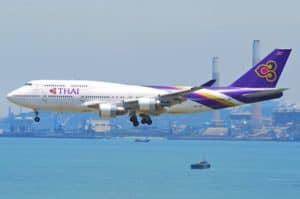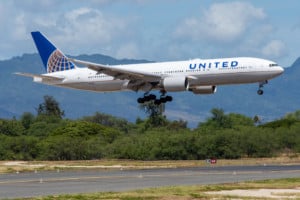They’re both big and fly long distances. But when stacking 747 vs 777, which one is better? Think about them in size, performance, range, and capacity.
But that’s just one side of the equation; when you look at cost, maintenance, and training requirements, the choice of aircraft becomes a bit more complicated. So, let’s break it down.
| Aircraft: | Boeing 747-400 | Boeing 777-200ER |
|---|---|---|
| Photo: |
 |
 |
| Country: | United States | United States |
| Manufactured: | from: 1989 to: 2005 | from: 1996 to: Present |
| ICAO: | B744 | B772 |
| Price: | $266.5 million | $306.6 million |
| Avionics: | Honeywell Avionics FMC , Rockwell-Collins CMC | Honeywell Avionics |
| Engine: | 4x P&W4000 / GE CF6 / RR RB211 | 2x Pratt and Whitney PW 4090 or Rolls-Royce Trent 895 or GE GE90-94B |
| Engine Type: | Turbofan | Turbofan |
| Power: | 63,300 pound-force | 93,700 pound-force |
| Max Cruise Speed: |
504 knots 933 Km/h |
510 knots 945 Km/h |
| Approach Speed (Vref): | 146 knots | 136 knots |
| Travel Range: |
7,285 Nautical Miles
13,492 Kilometers |
7,510 Nautical Miles
13,909 Kilometers |
| Fuel Economy: |
0.13 nautical mile / gallon 0.064 kilometres / litre |
0.17 nautical mile / gallon 0.083 kilometres / litre |
| Service Ceiling: | 45,000 feet | 43,100 feet |
| Rate of Climb: |
1500 feet / minute 7.62metre / second |
3000 feet / minute 15.24metre / second |
| Take Off Distance: |
2815 metre 9,235.45 feet |
2438 metre 7,998.59 feet |
| Landing Distance: |
1905 metre 6,249.92 feet |
1554 metre 5,098.36 feet |
| Max Take Off Weight: |
396,890 Kg 874,984 lbs |
297,550 Kg 655,979 lbs |
| Max Landing Weight: |
295,740 Kg 651,988 lbs |
213,180 Kg 469,977 lbs |
| Max Payload: |
71,395 Kg 157,397 lbs |
59,422 Kg 131,002 lbs |
| Fuel Tank Capacity: |
57,285 gallon 216,847 litre |
45,220 gallon 171,176 litre |
| Baggage Volume: |
160 m3 5,650 ft3 |
162 m3 5,721 ft3 |
| Seats - Economy: | 416 seats | 440 seats |
| Seats - Business Class: | 524 seats | 400 seats |
| Seats - First Class: | 416 seats | 301 seats |
| Cabin Height: |
2.54 metre 8.33 feet |
2.2 metre 7.22 feet |
| Cabin Width: |
6.13 metre 20.11 feet |
5.86 metre 19.23 feet |
| Cabin Length: |
57 metre 187.01 feet |
49.1 metre 161.09 feet |
| Exterior Length: |
70.66 metre 231.82 feet |
63.7 metre 208.99 feet |
| Tail Height: | 19.41 metre - 63.68 feet | 18.5 metre - 60.69 feet |
| Fuselage Diameter: |
6.49 metre 21.29 feet |
6.19 metre 20.31 feet |
| Wing Span / Rotor Diameter: |
64.9 metre 212.92 feet |
60.9 metre 199.80 feet |
| Wing Tips: | Canted Winglets | No Winglets |
| More Info: | Boeing 747-400 | Boeing 777-200ER |
|
Data presented is for entertainment purposes and should not be used operationally.
|
Other Boeing 747-400 comparisons:
Other Boeing 777-200ER comparisons:
About the Boeing 747
Boeing 747 is an American wide-body commercial jet airliner and cargo aircraft. The distinct hump with the upper deck and aircraft forward part makes it among the world’s most identifiable aircraft.
Why was it developed and built?
The Boeing 747 was developed and built to meet the growing demand for air travel between continents. As technology advanced and airline routes became more widespread, the Boeing 747’s larger cabin and greater range made it the ideal place for long-distance international flights.
What purpose does it serve?
The Boeing 747 is a long-range, wide-body airliner with the capacity to carry up to 467 passengers and cargo. It is used for international flights and is the flagship of many airlines.
About the Boeing 777
Boeing 777 is an American long-range, wide-body airliner. It is the world’s largest twinjet and offers a mix of efficiency, range, and capacity.
Why was it developed and built?
The Boeing 777 was developed as an improvement to long-range air travel. It was designed to provide airlines with an efficient yet spacious plane that could travel longer distances than its predecessors.
What purpose does it serve?
The Boeing 777 serves primarily as a long-haul airliner, capable of carrying up to 317 passengers over great distances. It is used for domestic and international flights and is the flagship of many airlines.
How are the Boeing 747 and Boeing 777 different?
The Boeing 747 is a wide-body jet airliner typically called a “jumbo jet.” Likewise, the Boeing 777 is called the “Triple Seven.” So, how do these two iconic airplanes compare? Let’s take a closer look.
Passenger Capacity
The Boeing 747 can seat 467 passengers in a typical configuration. Likewise, the Boeing 777 can seat between 305 and 368 passengers in a three-class configuration and between 313 and 396 passengers in a two-class configuration.
Range
The Boeing 747 ranges from 10,800 km to 14,320 km. The Boeing 777 ranges from 9,700 km to 15,843 km. So, if you’re looking to fly further without stopping for refueling, the Boeing 777 is your best bet.
Speed
The Boeing 747 cruises at Mach 0.855, and the Boeing 777 cruising speed is 0.87-0.89 Mach. They are both large airplanes with long ranges and high speeds. And while they share some similarities, there are also some critical differences between them. How are the Boeing 747 and Boeing 777 similar?
So, what are the similarities between these two planes?
Both Planes Were Designed for Long-Distance Travel
The Boeing 747 was designed for long-distance travel from the very beginning. It was created to transport large numbers of passengers over long distances quickly and efficiently.
The Boeing 777 was also designed for long-distance travel, although it wasn’t initially intended for commercial use. Instead, it was developed to replace the aging Boeing 767 models.
Both Have a Distinctive Shape
The Boeing 747 is easily recognizable thanks to its unique shape. The plane’s main body is oval-shaped and has a large bulge on the upper part of the fuselage (this is where the First Class cabin is located).
The Boeing 777 also has a distinctive shape, although it’s not quite as noticeable as the Boeing 747’s. The plane’s main body is elongated and has a small hump on the upper part of the fuselage (this is where the First Class cabin is located).
Both Have Wide Bodies
The Boeing 747 and Boeing 777 have wide bodies, allowing them to accommodate more passengers than narrower planes like the Boeing 737 or Airbus A320.
The Boeing 777 is wider than the Boeing 747! This makes it one of the largest passenger planes in operation today.
Both Utilize Twin Engines
The Boeing 747 and Boeing 777 utilize twin engines, which help to improve fuel efficiency and reduce operating costs. In addition, having two engines also increases safety in case one engine fails during a flight. Also, do you know why the old turboprops are still used?
What’s better about the Boeing 747?
Many features make the Boeing 747 a superior aircraft.
- First and foremost, it has a much larger capacity than most other planes, which makes it ideal for long-distance travel.
- Additionally, the Boeing 747 is equipped with four engines, providing extra power and reliability.
- The plane’s unique design also allows for a smoother and more comfortable ride.
- Finally, the Boeing 747 has a reputation for being one of the safest planes in the sky, which is a significant selling point for many travelers.
These factors make the Boeing 747 an excellent choice for airlines and passengers.
What’s better about the Boeing 777?
Boeing’s 777 is one of the sky’s most reliable and efficient planes. Here are just a few things that make it better than other planes:
- The Boeing 777 has a unique twin-engine configuration that helps to improve fuel economy.
- It is also incredibly quiet, thanks to features like advanced soundproofing and engine design.
- The plane is very comfortable for passengers, with wider seats and more legroom than most other planes.
- It also has a reputation for being one of the safest planes in the sky, with an excellent safety record.
Whether a passenger or a pilot, the Boeing 777 will surely give you a smooth and enjoyable flight.
Conclusion
The Boeing 747 and Boeing 777 are among the most advanced planes in aviation. Both aircraft share some common features, such as their long-distance travel capabilities and wide bodies, but they also have distinct characteristics.


